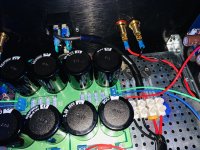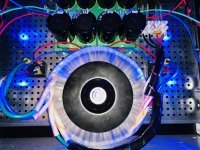That certainly doesn't sound optimum. That "protection" strip that you are plugged into may be doing more harm than good.It looks like I have about 20mV of DC on the line into the amp. Is that enough to cause buzz problems? I'm not sure what a typical number looks.
That certainly doesn't sound optimum. That "protection" strip that you are plugged into may be doing more harm than good.
I've tested it at various circuits around the house, and it's pretty consistent at 20mV. I've been unplugging/turning off everything around the house, but nothing is really having an impact on that number.
Thanks for the advice guys, I'll go with 30 Ohms with my 19v psu as this should give me approx 500ma which is roughly the same bias as final use in a Aleph J..?
No, in final use it will be running more current. However, if you match them with more current then the voltage will be changing faster as they heat up faster, so it's harder to get a good average reading. With 170mA to 500mA it will rise slowly enough that you can wait a few seconds and then write down what your multimeter shows.
Devices matched at 170mA or 500mA tend to be fairly well matched at higher values as well, so it's a good compromise.
Well, this is how I understand it, anyway. If I'm wrong someone will be along shortly to set me straight. 🙂
I've tested it at various circuits around the house, and it's pretty consistent at 20mV. I've been unplugging/turning off everything around the house, but nothing is really having an impact on that number.
If you have the option and it’s your house and not a apartment building. You can go to the circuit breaker on the main panel turn off all the breakers except the one that goes to the one circuit that you will be using.
This will make sure things like transformers from doorbell ringer‘s or circuit boards and transformers that are always powered up inside air-conditioning units or heater furnaces they never turn off.
And the next to last extreme measure remove the fluorescent light or LED light in the room and replace it with an incandescent lightbulb.
After all that then you’re 100% sure it’s in your transformer or coming down the powerlines from a neighbors house somewhere in the neighborhood.
You can go to the circuit breaker on the main panel turn off all the breakers except the one that goes to the one circuit that you will be using.
Great suggestion! I just finished up – shut off every single breaker except my audio circuit. Killed anything on the circuit that wasn't part of my system, and then turned everything off individually. All said and done and... still seeing 20-25mV of DC on my lines. 🙁
That might be the multimeter inaccuracy... try the snubber.
Rotate the transformer around, slowly and see if there's any change...
Rotate the transformer around, slowly and see if there's any change...
That might be the multimeter inaccuracy... try the snubber.
Rotate the transformer around, slowly and see if there's any change...
Also a great point. Next steps are snubber and playing with the positioning/mounting of the toroid.
Is it advisable to put the snubber network Eric described before the transformer in this instance? Right now I have a 3300pf line cap at the AC input bridge.
Please note: this is my first rodeo 😀
Please note: this is my first rodeo 😀
That snubber goes AFTER the transformer, on the secondary, at the bridge or input of the PSU.
Is it advisable to put the snubber network Eric described before the transformer in this instance? Right now I have a 3300pf line cap at the AC input bridge.
Please note: this is my first rodeo 😀
Snubber goes where the secondary windings connect to bridge rectifiers.
DO NOT place the snubber at the primary side.
3.3nF / 250V AC cap is okay in parallel to the primary.
...hmmmm... I would place the transformer next to the IEC (110V AC mains IN) connector, crimp (use the crimping lugs) the thermistors straight to the bare copper wires (no need for a terminal block), and drastically shorten the mains wiring. All of this can be floating on top of a transformer, or use 3 raiser pannels.
Sounds good on snubber. Here are a couple of detail pics of where I’m at now. Let me know if you see areas for improvement (aside from the shortening of mains wire and including a snubber)
Attachments
The mains wiring runs in parallel with one of the secondary wiring. There's the reason why the manufacturer chose to separate primary and secondary wirings' tails as much as possible🙂.
Anyway, I would look at shortening the mains wiring.... or at least, getting rid of a terminal block, and then running the full mains loom length between the "floating chassis" and the case bottom plate.
But, you should definitely consider my suggestion to shorten the mains wiring, as I already mentioned in my previous post.
Anyway, I would look at shortening the mains wiring.... or at least, getting rid of a terminal block, and then running the full mains loom length between the "floating chassis" and the case bottom plate.
But, you should definitely consider my suggestion to shorten the mains wiring, as I already mentioned in my previous post.
Tested all my FETS with 19v and 33 Ohms for 30 seconds each
Hopefully that should be accurate enough? I used 4x 8.2r 10w resistors in series and they only got slightly warm.
Hopefully that should be accurate enough? I used 4x 8.2r 10w resistors in series and they only got slightly warm.
That should be fine. The important thing is to try to be consistent with the
timing and keep the parts them at the same temp when you start.
timing and keep the parts them at the same temp when you start.
Pass DIY Addict
Joined 2000
Paid Member
BTW, thanks for the link to your site Eric, makes for some great reading!
Glad that you found it useful! I still have some work to do restoring content after my employer killed personal webpages that caused me to port thing to a new location.
Buzz update
I opened the amp up and repositioned, twisted, loosened, etc the toroid, all with no change to the buzz sound. Also repositioned some of the connections based on feedback. I heard back from John at Antek, and he thought 20mV DC on the line was negligible and wouldn’t cause the buzz. He’s sending out a new transformer on Monday, so we’ll see if it’s the transformer or something else. Will report back.
I opened the amp up and repositioned, twisted, loosened, etc the toroid, all with no change to the buzz sound. Also repositioned some of the connections based on feedback. I heard back from John at Antek, and he thought 20mV DC on the line was negligible and wouldn’t cause the buzz. He’s sending out a new transformer on Monday, so we’ll see if it’s the transformer or something else. Will report back.
I opened the amp up and repositioned, twisted, loosened, etc the toroid, all with no change to the buzz sound. Also repositioned some of the connections based on feedback. I heard back from John at Antek, and he thought 20mV DC on the line was negligible and wouldn’t cause the buzz. He’s sending out a new transformer on Monday, so we’ll see if it’s the transformer or something else. Will report back.
Good to hear that Antek has great customer support! Hopefully the new toroid solves the issue, keep us up to date.
I opened the amp up and repositioned, twisted, loosened, etc the toroid, all with no change to the buzz sound. Also repositioned some of the connections based on feedback. I heard back from John at Antek, and he thought 20mV DC on the line was negligible and wouldn’t cause the buzz. He’s sending out a new transformer on Monday, so we’ll see if it’s the transformer or something else. Will report back.
I used Antek, 500VA "unshielded" version and it is quiet as a mouse...dead silent in fact with very efficient speakers. Nothing noteworthy in terms of wiring, fairly straight forward....will post internal pic when my cat gets off of it!
Attachments
- Home
- Amplifiers
- Pass Labs
- Aleph J illustrated build guide


![IMG_4733[1].JPG](/community/data/attachments/716/716811-7da74ca9cc089f55a77b633764a7ff36.jpg?hash=fadMqcwIn1)